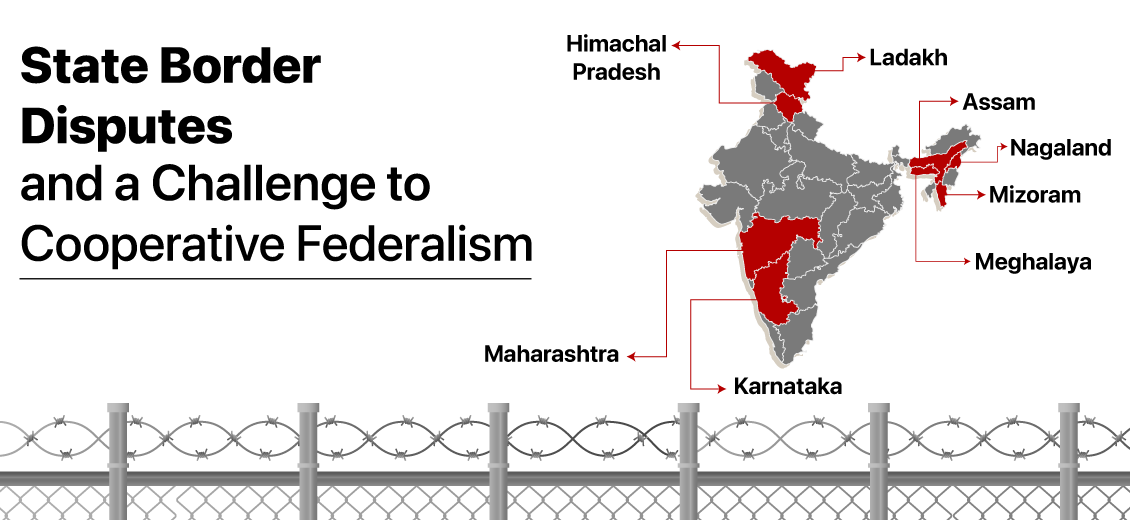State Border Disputes and a Challenge to Cooperative Federalism
Blogs Home
- 09 Mar 2023

The Indian model of federalism has often been described as "Cooperative Federalism". Simply put, it signifies the belief that the Central governments and State governments should be interdependent. This is in contrast to the typical feature of federal countries, where the jurisdiction of the Center and State are independent of each other.
The Indian model of federalism is unique in itself. This is majorly in two ways. First, the Constitution of India does not use the word "federal" anywhere. Second, it departs from the typical feature of federal systems since it does not provide complete independence to regional and federal governments in their sphere of authority. The power-sharing between the Centre and States in India has been categorised under "holding together federalism" as opposed to “coming together federalism.”
However, this is not without its challenges. One such major challenge that clouds the federal system of India is the increasing number of State Border Disputes.
Some of the major state border disputes have been explained below:
Karnataka-Maharashtra Dispute
One of the major bones of contention between the state of Karnataka and Maharashtra has been the dispute over the Belgaum/Belagavi District, which is currently a part of Karnataka State. Over the past few months, the conflict has intensified between the two states. With the States Reorganisation Act of 1956 that drew the state boundaries on a linguistic basis, Belagavi became a part of the then-Mysore State. In the region, a majority of the population speaks the Marathi language and this forms the basis of Maharashtra's claim of having certain parts of Belagavi as a part of Maharashtra. The center attempted to resolve the dispute between the two states by setting up Mahajan Commission in 1966, which recommended that the district should remain with Karnataka. This was rejected by Maharashtra.
Whereas Maharashtra wishes for a readjustment of the region based on the contiguity (closeness) of the region, Karnataka has underlined that the boundaries as per the Act of 1956 should be final. A demand to reopen the border issues that have not been dealt with under the State Reorganisation Act should be scrapped or else, it would lead to an increasing number of such issues.
One of the ways to settle the issue is to seek the Supreme court to resolve the dispute. As per the Original Jurisdiction of the Supreme Court, under Article 131 of the Constitution, the SC resolves disputes between the Government of India and any one or more states, or between two or more states against one another. In 2004, the Maharashtra government moved to SC. Political parties on both sides have raised the issue and maintained their opinion on the same. The Union Home Minister, Amit Shah has urged the leaders on both sides to wait for the Supreme Court's verdict. This is only one of the recent cases that present to us as a manifestation of the challenges to the case of Indian federalism.
Disputes in North East Region
The states of the northeast experience various state border disputes. This has been a trend since the 1960s.
One of the recent border disputes has been between Assam and Mizoram states. In July 2021, the conflict saw violence, followed by accusations by the Mizoram Government of Assamese officials for encroaching upon the Aitlang Hnar area in Mizoram. Assam on the other hand accuses Mizo residents of encroaching on Assamese territory. Mizoram was carved out of Assam in 1972, and it gained full statehood in 1987. The conflict between Assam and Mizoram can be traced to two notifications issued in the British era in 1875 & 1933 when Mizoram (known as Lushai Hills) was only a district of Assam. The notification of 1875 differentiated between Lushai Hills from Cachar Plains. Mizoram insists on the boundary that was decided by this notification of 1875, whereas Assam follows the boundary as per the demarcation in 1986 which is based on the 1933 notification.
There are various other border disputes with Assam. One of the bloodiest disputes has been between Assam and Nagaland. This state border dispute between Assam and Nagaland is a protracted border conflict in the North East. This was following the status gained by Nagaland to be a state in 1963. The Nagaland State Act, of 1962 defined the state borders as per the 1925 notification. Nagaland does not accept this delineation and demands that it should have all Naga-dominated areas, including North Cachar and Nagaon district. The first border clash between them was in the year 1965, followed by the years 1968, 1979, 1985, 2007, 2014, and even 2021. However, In January 2022, the Nagaland CM informed that both states are ready for an out-of-court settlement.
Assam has a maximum number of state conflicts. Another such conflict is between Assam and Meghalaya. It gained the status of a full-fledged state in 1972. The dispute between the two arises from Meghalaya government's denial of the Assam Reorganisation (Meghalaya) Act. This Act gave the two areas, Block I and II of Mikir Hills, or present-day Karbi Anglong district to Assam. As per Meghalaya, both these areas were a part of United Khasi and Jaintia Hills districts. The government of Meghalaya bases its claims on the maps of the years 1872 and 1929 whereas Assam wishes to follow the recommendations given by the Churchand Committee (formed under Justice Y.V. Chandrachud in 1985) that has been rejected by Meghalaya. Last year, in November 2022, the region once again witnessed a violent clash leading to the killing of six people and several injuries.
Himachal Pradesh And Ladakh
The claim over the Sarchu region is the cause of the dispute between Himachal and Ladakh. This area lies on the route between Leh and Manali. Sarchu lies between the Lahaul-Spiti and Leh. This is the last station of the Lahaul-Spiti district, and lying on the Manali Leh highway it attracts various tourists. Both states have placed various records as evidence to show their claims.
All the above-mentioned border disputes are examples of challenges that a federal country like India faces. Regardless of the reasons for their occurrence as mentioned before, one can certainly say that they are bumps on the road of federalism and demands for strengthening of "cooperation" to be termed as a truly cooperative federal system.
There have been attempts by the Center to play the role of facilitator and various committees have been set up to resolve the disputes. Nonbinding in nature, their recommendations have been rejected by the state governments. PM Modi has urged the states to follow a spirit of "cooperative, competitive federalism" with the famous slogan "sabka saath, sabka vikas" for the sake of development. However, when federalism is talked about, there is an emphasis only on how to improve and strengthen the relationship between the Center and States, ignoring the fact that the disputes between various states also create difficulties for the efficient functioning of a federal system. Cooperation is necessary, between Union and State and between and among States. Perhaps, an active revival of the Inter-State Council constituted under Article 263 of the Constitution can be the first step in this direction.
Sources:
https://www.idsa.in/issuebrief/disputes-in-northeast-india-pdas-290721
Annie Pruthi
Annie Pruthi is currently pursuing her masters in Political Science from JMI, New Delhi, and is a first division Arts graduate from the University of Delhi. She is an avid reader and an award-winning best-selling author. Her book "Will You Stay?" won the title of "Most Promising Book, 2020 (Fiction)" in the Coimbatore Literary Awards.
Blogs Home




